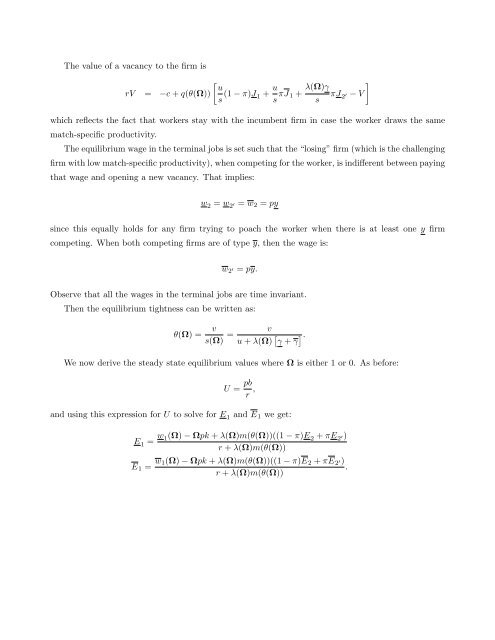Unemployment cycles
WP201526
WP201526
You also want an ePaper? Increase the reach of your titles
YUMPU automatically turns print PDFs into web optimized ePapers that Google loves.
The value of a vacancy to the firm is<br />
[ u<br />
rV = −c + q(θ(Ω))<br />
s (1 − π)J 1 + u s πJ 1 + λ(Ω)γ ]<br />
πJ<br />
s 2 ′ − V<br />
which reflects the fact that workers stay with the incumbent firm in case the worker draws the same<br />
match-specific productivity.<br />
The equilibrium wage in the terminal jobs is set such that the “losing” firm (which is the challenging<br />
firm with low match-specific productivity), when competing for the worker, is indifferent between paying<br />
that wage and opening a new vacancy. That implies:<br />
w 2 = w 2 ′ = w 2 = py<br />
since this equally holds for any firm trying to poach the worker when there is at least one y firm<br />
competing. When both competing firms are of type y, then the wage is:<br />
w 2 ′ = py.<br />
Observe that all the wages in the terminal jobs are time invariant.<br />
Then the equilibrium tightness can be written as:<br />
θ(Ω) =<br />
v<br />
s(Ω) =<br />
v<br />
u + λ(Ω) [ γ + γ ].<br />
We now derive the steady state equilibrium values where Ω is either 1 or 0. As before:<br />
U = pb<br />
r ,<br />
and using this expression for U to solve for E 1 and E 1 we get:<br />
E 1 = w 1(Ω) − Ωpk + λ(Ω)m(θ(Ω))((1 − π)E 2 + πE 2 ′)<br />
r + λ(Ω)m(θ(Ω))<br />
E 1 = w 1(Ω) − Ωpk + λ(Ω)m(θ(Ω))((1 − π)E 2 + πE 2 ′)<br />
.<br />
r + λ(Ω)m(θ(Ω))


